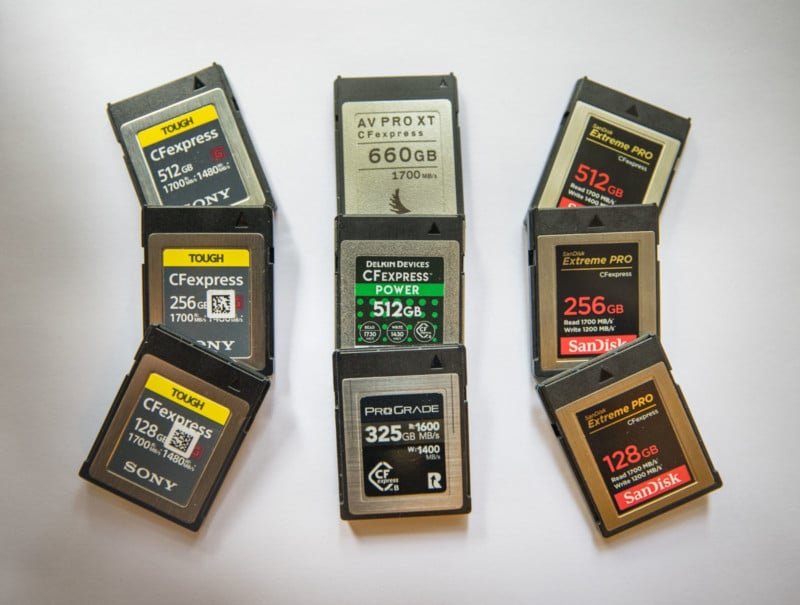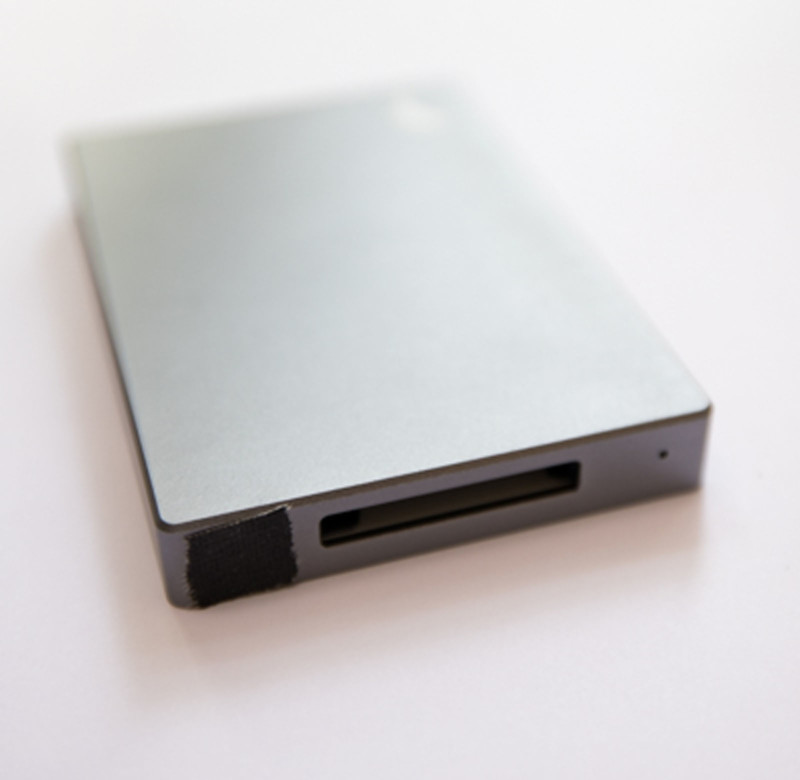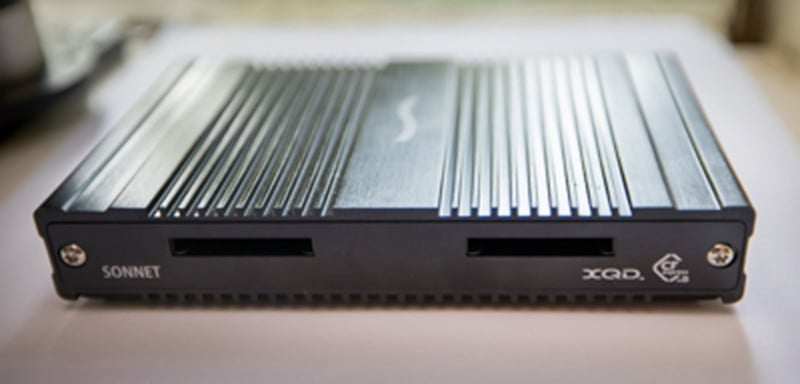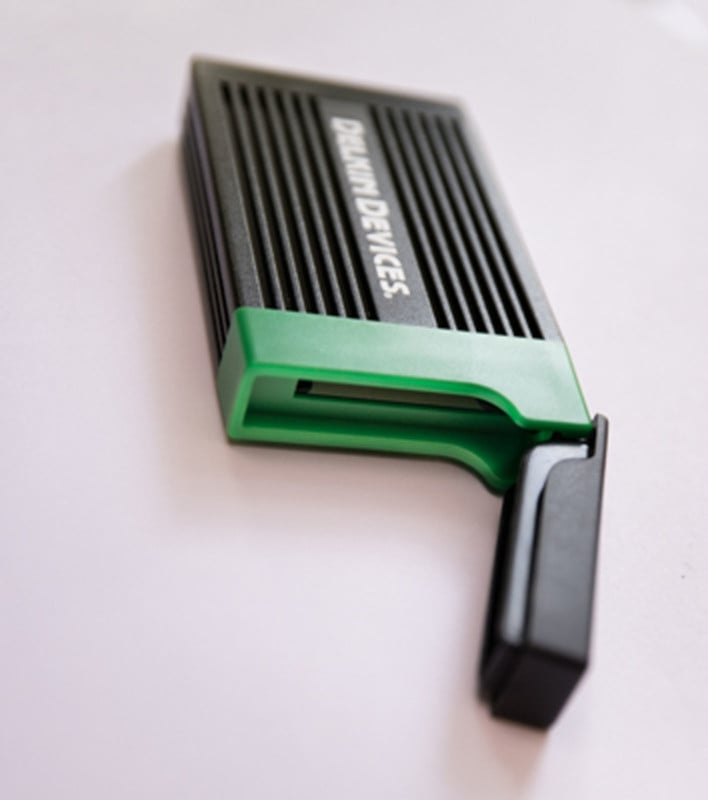CFexpress: A Real-World Performance Comparison
![]()
The newest, best cameras coming on the market use a new kind of memory card called CFexpress Type B. They’re fast, but they’re new, so users don’t really have an impression of which ones might be better to buy. This review shows tests from the better of the ones available and presents the results so that readers can use the factors most important to them to choose the best card for themselves.
The Upshot
- If you want the best price per GB, you’ll have the Delkin Power 512GB, which is also one of the top 5 in performance. The larger versions of these cards are even cheaper per GB; less than half the average price per GB of the other cards.
- If you want the most number of shots in 30 seconds, you’ll have the Angelbird 660GB XT. But it’s best by only 1 picture out of 337, and it has an odd behavior of causing camera startup to take 4 more seconds than any other card. This will be a deal-breaker for some.
- The card that clears the buffer the fastest is the SanDisk Extreme Pro 512GB, clearing it more than half a second faster than the other cards of its capacity. [Note the late entry of the Lexar Professional 512 GB card after this article was written upset this record, but both are fantastic at clearing cache.]
- The best all-around card is arguably the ProGrade Cobalt, which doesn’t win outright in any category, but ties for first in several of them.
- The card that takes the most shots before the buffer kicks in while shooting in mechanical shutter is the Delkin – but by just a smidge.
- The cards that perform best as hard drives hooked up to the computer are the Sony cards. They’ll offload images and video faster than the others.

So let’s get to the measurements…
Yeah, they’re all over the map, so to make a good buying decision, you need to look at the sorts of shooting you do, and which factor is most limiting. As an example, I shoot wildlife. It’s a long, arduous, quiet day until all of a sudden I need to lay down as many frames as possible without the camera stuttering. If I’m lucky, I’m going to need the buffer to clear and do it again, but mostly I’m worried about that first, long drag of shots.
A sports photographer might be doing short, regular bursts, with the buffer inflating and deflating rhythmically. A birder might prioritize the speed to the first shot, with the camera and card needing to wake up for an instant stab at a passing bird.
Note: The comparisons below were shot on a Canon EOS R5 camera.
Raw Speed
![]()
It has to be said that the CFexpress format is a leap forward. The cards are all so fast that the difference between the top performer in clearing a full buffer and the card that came in second from last is just 1.5 seconds. The buffer is that on-board, super-fast memory that fills up, and then you’re just left with the raw speed of your memory card, chewing through what the buffer can upload to it.
That the memory cards can eat up the full buffer so quickly now has implications for people thinking about which factors are most important. If clearing the buffer is the difference between 4.5 and 6 seconds, it might not be as big a priority as it used to be. In the old days (2019), the difference between cache clearing in one card to another could easily have been more than 15 seconds. When shooting SD cards on the Sony a9, it seemed you could do your laundry and have a little time left for a snack while the buffer unloaded to the memory card.
With CFexpress, buffer clearing times are just less important. All that said, the SanDisk 512GB card [and now the Lexar 512 GB card] are tops at clearing the cache, as the chart above shows. This is the time it takes to completely move the contents of the cache to the card. In the Canon EOS R5, this appears to be about 2 GB of data, or about 40 shots. (The cache will appear to be about 60 shots deep because fast cards will allow you to fill up about half again as much data during the time it is uploading to the memory card. This number – reported in the viewfinder for those who have it set so – will vary mostly based on the ISO setting, as that will affect the size of the files.)

Buffer +
![]()
A critical factor – perhaps the most important for sports and wildlife shooters – is the number of shots you can rip before you get the unpredictable stutter of a full cache. In mechanical shutter at 12 FPS, the R5 will give you between 10 and 15 seconds of glorious, uninterrupted shooting. This is the sum of the buffer and the number of shots a card can manage to ingest while the buffer is filling. The Delkin consistently took the lead here.
Of interest here is the fact that Sandisk’s smaller card sizes – which sport very similar performance metrics on the label – perform terribly relative to the 512 GB card. Unfortunately, this seems to be the norm. Sony’s smaller sizes also perform poorly in the other tests relative to the 512 GB, although they are keeping up with their bigger sibling in this test of initial speed capacity.
Heat
An early version of our cache depth test showed much more variation among the cards, but we discovered that running tests very quickly, one after the other, would increase a card’s temperature, and this write performance would be throttled. It appears from talking to reps at multiple manufacturers that this is something that will be true for all CFexpress cards. It also appears to be the reason you don’t see people brandishing minimum write speeds — because it is very temperature-dependent. It also may be because an “effective minimum write capacity” number that indicated a speed below 40 degrees celsius would be embarrassingly low – likely around 550 MB/sec. for the best cards, which wouldn’t look cool emblazoned on a card label.
The good news is that there are very few people who will use their cards more intensively than we did for these tests, and the cards very rarely got hot enough to affect performance. After shooting about 3,500 stills in a row, formatting the card after about every 300, we saw some performance degradation that may have been heat-related. This is likely an area that video shooters will be more concerned about.
We did keep track of temperatures after this, monitoring how much the temperatures rose between each run of 30 seconds of shooting. It was so consistent among the cards, it’s not worth reporting other than to say that we’d see a roughly 2 degree Celsius increase per run, and simply plugging 5 numbers into a computer between runs and formatting the card would provide enough time for the camera’s card slot to lose 1 degree. We never saw odd performance changes below 50 degrees C, and stills shooters are unlikely to see those temps.
Even after several thousand shots in a few minutes, the cards were typically measured to be only in the mid-40s. Stills photographers won’t need to worry, but video people may find some cards lower writing capacity below the bitrate required for 8k shooting once a certain heat level is reached. More likely, the R5 will stop recording due to its own heat detection firmware routines. Video users of the R5 should be using an external recorder for high bitrate clips longer than a few minutes. That also has the benefit of removing recording time limits. The Ninja V external recorder today costs roughly the same as one of the 512 GB cards in this review.
Another alternative to using CFexpress cards and putting that heat internally in the camera can be found with the just-released ZITAY XFexpress to SSD Converter, reviewed by Matthew Allard over at Newsshooter.
Shots Per Half-Minute
![]()
Here is what happens when you set a camera on electronic shutter (20 frames per second) and mash that trigger for half a minute. The scale of this chart starts at 250 images, which exaggerates the differences between the cards. All the cards perform decently, even the pokey SanDisk ones of 256GB and below.
Here is where you see the smaller cards in the Sony system also start to falter, even though their labels claim equivalent performance with the 512 GB version.
It should be said that each of these cards has a different shooting rhythm style. The Sony 512 has a pleasing, consistent rhythm to the shots, shooting roughly equal amounts on and off after filling the buffer. The Lexar is a big more syncopated, perhaps less predictable. The Angelbird and ProGrade cards create more tension, with a spattery non-pattern. You never really know in which tenth of a second the shutter will start up again, or for how long.
The affordable Delkin surprises here by coming in 8th after winning the buffer test that showed how many uninterrupted frames it could take before the buffer caused skipping. It appears to be a sprinter of a card, perhaps with firmware that is more cautious on heat throttling, but that is just speculation.
![]()
The chart above shows the performance of the cards in mechanical (first curtain) shutter mode. This is favored by many with the R5 because its maximum of 12 frames per second is a reasonable rate when you’re not trying to capture the fastest movements. It’s also not very loud for a mechanical shutter. The R5 forces electronic shutter users into the 20 fps rate, which often is a drain of time later when culling pictures. By and large, the cards keep their relative rankings. The scale of this chart changes to a minimum of 200 frames, so the two charts of how-many-frames-in-30-seconds aren’t as different from one another as might initially seem.
Speed Claims
![]()
Below, is a table of the claimed maximum write and read speeds of the cards. As discussed earlier, dynamic heat reactions prevent there being a real minimum write speed figure, but even so, these maximum speeds show the manufacturers being pretty generous with themselves. These numbers are an industry convention that doesn’t have a great deal to do with actual card performance. To round out the table, we added a couple of additional rows with information just slightly more useful than the marketing claims.
The “Spooling Up” Gotcha
![]()
When looking at online forum discussions for Canon EOS R5 performance, we noticed that several people seemed to think that the R5 had a terribly long initial startup time, making it inconvenient for action and wildlife photographers. Many of us other R5 owners were puzzled by this, as the spooling-up time seemed to be impressively short.
Over the course of jockeying CFexpress cards through the camera for a few days, we may have discovered why some are affected by this and not others. The camera “polls” the cards upon startup, and some can cause the camera to spend an extra 4 seconds during that time. In our tests, one in particular showed this: the Angelbird 660 XT GB. This isn’t as crippling as it may sound, as this polling happens only in two cases; during the turning on phase, and right after a card formatting. So if a user leaves the camera on, merely waking up a viewfinder won’t trigger the extra delay. But turning your camera off after each shot will.
What About Video?
Meh. Video people really need a binary answer of yes or no… Does this card write the desired video format and not skip frames? With all of the cards in the first tier of performance, they can write 8k or 4k HQ video until they are full; or more likely, until the R5 gives them an overheating timeout. So, there. We did video.
Of course, if you’re using the R5, and you’re at all serious about video, you’re recording to an external recorder, and the memory card is precisely the thing you’ve removed and put aside. There is some thought that some CFexpress cards may generate more heat than others. At the request of a forum dweller over on FredMiranda.com, we measured before and after temperatures during a test run of all of the cards, making sure the camera’s slot had cooled to at least a common maximum temperature (45 C). Keeping the temperature to that or lower, we saw no degradation in the data with higher temps.
Price
Price mattered to start, of course, but when you figure out that the performance on these cards is pretty consistently good, price takes on even greater importance as a differentiator. Here’s the breakdown of prices as of mid-September 2020 at B&H…
![]()
CFexpress Card Reading/Writing
![]()
CFexpress cards, like their predecessors the XQD cards, act essentially as SSD drives when put into a card reader. When mounted as a drive tools such as Black Magic Design’s Speed Test application can be used to compare their performance for reading and writing without the camera hardware and firmware interfering. When we do this with the 10 tested cards, we find a few interesting things:
1. There is some correlation between drive performance and actual performance in terms of throughput when used in a camera. The chart here shows a comparison of the drive performance (orange) versus the number of frames that can be blasted through the card in 30 seconds on an R5. These numbers are presented as indices, not actual performance metrics.
2. Potential performance as a drive is much higher than actual delivered performance in a camera – by roughly a factor of 2. Even more interesting, that drive performance is only about half as fast as the claimed maximum performance. This means that the R5 is currently getting about a quarter of the performance promised by the maximum write figures.
3. The correlation between drive performance and camera performance is inconsistent for some cards. This may have to do with firmware differences. Some smaller-than-512 GB cards seem to have similar performance between functioning as a drive on a computer and functioning as a memory card in the camera, where the others show much better performance when used as a drive.
![]()
In conducting the tests for the cards hooked up to a computer, we saw some very strange results, eventually figuring out that major differences would be introduced not only by using different card readers, but also even which port we chose to hook it up to on the computer, and also what sort of cord was used. These results retested, standardized on a Sonnet dual CFexpress card reader using a Thunderbolt 3 port and cord.
[We will soon have a review available comparing this reader to the Delkin Devices card reader and the Angelbird card reader, both of which use USB 3.2 ports.]
Our experience was that on a USB port, the Sonnet was slower than the other two, but on the Thunderbolt port, the Sonnet was fastest yet. Combine that with different cords providing different bandwidth, and some computers having different levels of USB support on different ports, this is rife for confusion and points out that people can compare their own bandwidth results to ours to see if perhaps they could get significantly better download rates by tinkering with those factors.
Service
In the course of comparing cards, we discovered two genuine bugs. In talking these over with the manufacturers, we were surprised to see them being very open about this, with them asking specific questions to help narrow down the problem. The two manufacturers, Delkin and Angelbird, were not apprised of the fact we were reviewing the cards and were treating us as just another customer.
When Delkin received word we had a problem with the card being read through a third party card reader, we got a call from the person who ran service at their California headquarters. When Angelbird was told of a very similar problem, they immediately sent one of their own card readers 1-day mail from Austria for free. In both cases, we had working cards in cameras within 36 hours. There are three important takeaways from this:
1. The CFexpress standard, as interpreted by camera manufacturers, is still being established in implementation, so we can expect issues to crop up as new cameras are introduced and firmware needs to be adapted. There is no amount of testing that would solve the issue of a third party camera maker launching a camera with a slightly different protocol interpretation a year later, so all manufacturers are likely as vulnerable to this problem as all the others.
2. The good news is that the card producers appear to be standing behind their cards both with a surprising service level, and also an attitude of collegial cooperation, using the customer community to help track down issues. In both cases, we had great follow-up communication to make sure we were shooting without issue. The best sales asset Delkin has is a guy named Mark, and for Angelbird it’s a fellow named Fabian. After all of this testing is over, I will personally be buying one more large card, and it’s likely going to be a Delkin or an Angelbird, partly due to performance/price, but also because they have given me the greatest confidence about their commitment to standing behind the cards.
3. The problems noted above can be solved with the use of either the Delkin or the Angelbird card readers, which each work fine with all 10 cards tested.
Methodology
All shots were taken as RAW files at 1000/th of a second. Two Canon R5 cameras were used to check the consistency of results. Both mechanical and electronic shutters were used in a significant number of tests, just to ensure that there wasn’t a relative difference in performance among the cards (there wasn’t), with one shooting 12 frames per second (FPS) and the other 20 FPS.
Two sets of data were taken at 250 ISO and at 3200 ISO to see if there were relative performance differences with the different sized files (there weren’t any observable). Some of the data averages are rounded to the nearest ten so we don’t mistakenly imply that our precision is better than it actually is.
Limitations:
- Only RAW was used.
- Temperature did not appear to affect performance – and this was tested – but the tests did not wait for the camera to cool down between each trial which would have been optimal. Instead, we just made sure the temps didn’t exceed 45C.
- Tests were limited to two R5 bodies and one sample each of all of the cards, except the Delkin, where we were able to get an early copy of the 512 GB version with the new firmware. Both Delkin cards performed similarly. Regarding the low sample sizes, the consistency between bodies makes me confident they aren’t introducing bias, but an anomalous performer among the cards would definitely goof up the results.
- Tests were locked down on a tripod with the same view (a carved duck decoy) with reproducible artificial LED light. The subject and environment provided very consistent, reproducible files, but it didn’t strain the camera in terms of tracking, battery use, etc. This was deliberate, as those factors would be difficult to reproduce perfectly for each testing series.
CFexpress Card Readers
Over the two weeks taken to construct this review, we found ourselves realizing we needed a broader view of the CFexpress card readers, to make sure that the single reader we originally had was not introducing any bias in the data rates between the cards and the computer. Firmware introduced by Canon’s slightly different implementation of the CFexpress standard also caused some issues with the original card reader.
Angelbird sent us a card reader for free to address a firmware incompatibility that appears to be primarily due to the Sonnet card reader’s firmware. They did this not knowing we were reviewing their card; a testament to their well-earned reputation for being very service minded. We purchased a Delkin reader to compare as well. There are a couple of additional popular readers available.



Conclusions
Relative to one another, the cards in the same class as one another showed only about 10 percent variance in performance. There certainly is shown a different set of classes, though, when looking at the 128 GB and 256 GB cards versus the higher capacity models. Those smaller cards get a roughly 20 percent performance hit on average. So, with everything performing at a very, very high level, and little variation among them, factors like price and service weigh heavily.
My own assessment is that Delkin wins here because the 512 GB card reviewed is less than $1 per GB, and they even sell one with four times the capacity for $0.50 per GB, which is less than half the cost per GB for most of the other brands’ largest cards. Their firmware issue was solved just this week with a new version. The card’s biggest downside is a longer full cache clearing (by 1.5 seconds) and a lower number of frames on very, very long shutter presses (>15 seconds). But it won the category for the number of shots taken in mechanical shutter before it stutters. That’s pretty representative. You can get the best card for the first 15 seconds of shooting, but that same card will perform in the lower half of the cards for the second 15 seconds of shooting. This sort of tradeoff is apparent with all the cards and across the different specs measured.
But, really, you can’t go wrong with that one, or the Angelbird XT 660GB, or the Prograde Cobalt 325GB, or the Sony Tough 512 GB, or the SanDisk Pro Extreme 512 GB, or – now – the Lexar Professional 512 GB. I’d just stay away from the sizes below those. Some of those larger cards will be a bit better in one area or another. If money isn’t an object, pick your most limiting factor and look at the relevant chart above to pick the winner. But for everyone else, just go get a big Delkin. And, while you’re at it, get one of those little Angelbird CFexpress readers, so you’ll never worry about which reader can read what card.
Even the people coming from the Sony A9 bodies or the Canon 1DX Mark III will find the throughput of the Canon R5 a bit mind-bending when using CFexpress cards. The SanDisk 512 card is pushing 560 GB per second to clear the cache. That’s 10 shots per second of 45 megapixel RAW files. That said, even the fastest performing card isn’t close to the claims on the labels. It is about 1/4 the capacity of the CFexpress standard (~2TB) and about 1/3 the claimed maximum write capability (~1.5TB). The implication is that better is still to come. A card functioning at the bandwidth claimed on these cards’ labels wouldn’t even need a cache. The card would suck in the data as quickly as the camera can produce it. I expect that will happen in a camera generation or two. We’ll be watching and reviewing.
Addendum: Late-Arriving Entrant: Lexar 512 GB
A couple of hours before this review was to be published, the FedEx man knocked on the door with a Lexar 512 GB card. The quick tests rushed to compare results showed that the SSD tests proved about 40 percent slower than the other 512 GB options. Despite this, the actual camera performance was pretty great. It beat even the SanDisk 512 for the fastest cache clearing and managed to average 305 shots in 30 seconds when mashing the trigger in both mechanical and electronic shutter. So we’ll add it to the list of cards that win in one category and that are roughly as good as all the other top-class cards. Interestingly, this one is also pretty inexpensive at $0.94 per GB.
TL;DR
Finally, we include a “too long; didn’t read” section below to show all of the tests across all of the original 10 cards. This may save you some reading, but it’ll certainly cause some squinting. We’ve titled this cityscape of a chart “Downtown CFexpressville.”
![]()
Special thanks to a few people who helped push this review along. Two Canon R5 shooters who wish to remain anonymous lent multiple CFexpress cards. LensRentals.com was able to provide a couple of the brands on short notice. Jeff, over at cameramemoryspeed.com gave great advice on figuring out methodology. Forum dwellers over at FredMiranda.com also helped figure out what tests would be most useful and helped inspire the effort in the first place.
About the author: Tig Tillinghast is a photographer based in Vermont. The opinions expressed in this article are solely those of the author. This article was also published at Camnostic.